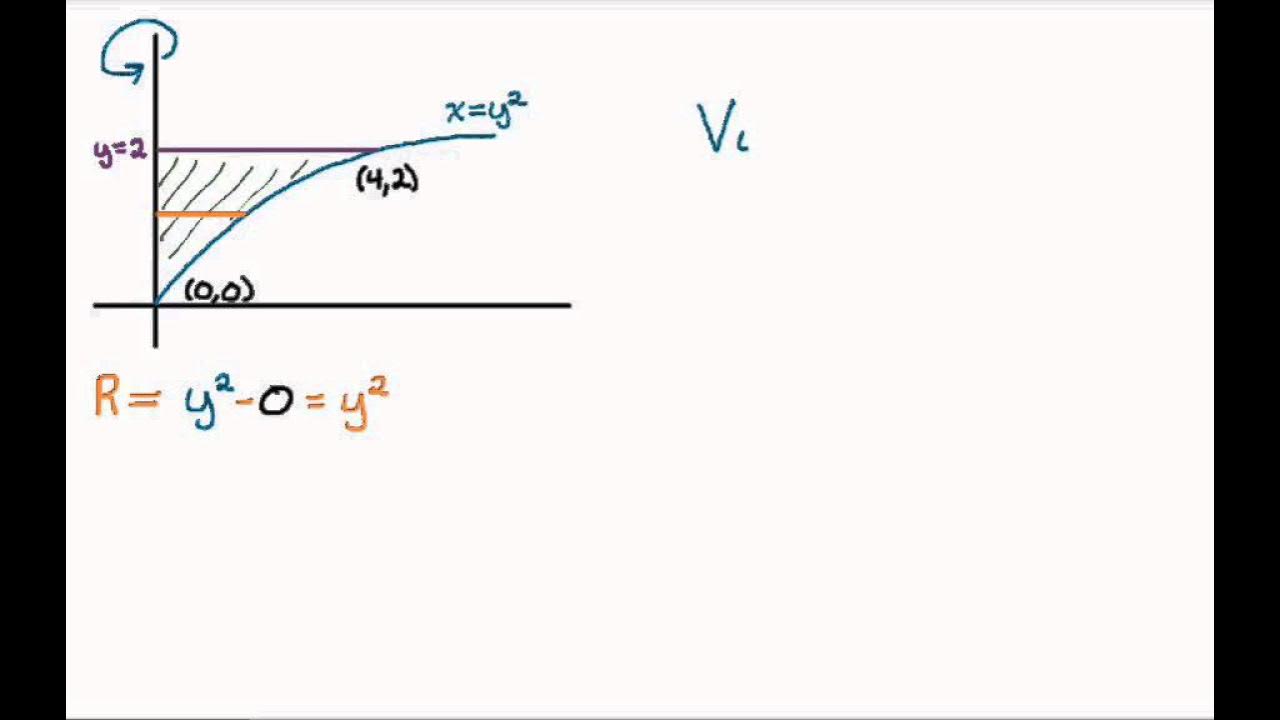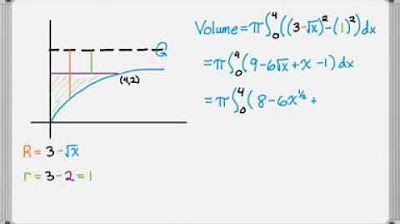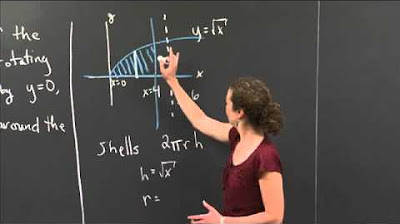Washer method rotating around horizontal line (not x-axis), part 1 | AP Calculus AB | Khan Academy
TLDRThe video script presents a mathematical problem involving the rotation of a region bounded by two functions around a horizontal axis to create a solid of revolution. The method of washers is introduced to calculate the volume of the resulting shape, likened to a vase with a hole at the bottom. The problem focuses on determining the outer and inner radii of the washers and setting up the integral for the volume, which will be evaluated in a subsequent video.
Takeaways
- 📈 The problem involves finding the volume of a shape created by rotating the region between two functions around a horizontal axis.
- 🎲 The two functions given are y = x and y = x^2 - 2x, and the region of interest is between these functions.
- 🔄 The rotation is around the horizontal line y = 4, not the x-axis, creating a vase-like shape with a hole at the bottom.
- 🏺 The method used to calculate the volume is the washer method, a variant of the disk method used for volumes of revolutions.
- 📐 The construction of a washer involves identifying the inner and outer radii based on the distance from the line of rotation to the curves defining the shape.
- 🧩 The outer radius is determined by the distance between y = 4 and the curve y = x^2 - 2x, which is 4 - x^2 + 2x.
- 🧩 The inner radius is the distance between y = 4 and the line y = x, which is simply 4 - x.
- 📐 The area of the washer's face is calculated by subtracting the area of the inner circle (π times the inner radius squared) from the area of the outer circle (π times the outer radius squared).
- 📊 The volume of one washer for a given x is found by multiplying the area of the face by the depth dx.
- 🌀 The total volume of the shape is obtained by summing up the volumes of all washers over the interval from x = 0 to x = 3, where the functions intersect.
- 🔢 The interval for the x-values is determined by setting the two functions equal to each other and solving for x, resulting in x = 0 and x = 3.
Q & A
What is the main problem discussed in the transcript?
-The main problem discussed is the calculation of the volume of a shape created by rotating the region between the functions y=x and y=x^2-2x around the horizontal line y=4 using the washer method.
What is the washer method?
-The washer method is a variant of the disk method used in calculus to find the volume of a solid of revolution when the revolution is around an axis other than the axis of the function, such as a horizontal line in this case.
What does the shape created by rotating the region look like?
-The shape created by rotating the region looks like a vase with a hole at the bottom.
How is the outer radius of the washer determined?
-The outer radius of the washer is determined by the distance between the line y=4 and the function y=x^2-2x, which is calculated as 4 - x^2 + 2x.
How is the inner radius of the washer determined?
-The inner radius of the washer is determined by the distance between the line y=4 and the line y=x, which is calculated as 4 - x.
What is the formula for the area of the face of a washer?
-The area of the face of a washer is given by π times the difference of the squares of the outer and inner radii, which is π(R^2 - r^2) where R is the outer radius and r is the inner radius.
How is the volume of one washer calculated?
-The volume of one washer is calculated by multiplying the area of its face by its depth (dx).
What is the interval of x values for which the volume of the shape is to be calculated?
-The interval of x values is from 0 to 3, determined by the points of intersection of the functions y=x and y=x^2-2x.
How many functions are involved in the creation of the shape?
-There are two functions involved: y=x and y=x^2-2x.
What is the equation that is set to zero to find the interval for x?
-The equation set to zero to find the interval is x^2 - 3x = 0.
What is the strategy to find the volume of the entire shape?
-The strategy is to sum up the volumes of all the washers for each x value in the interval from 0 to 3 and take the limit as the depth dx approaches zero.
Outlines
📐 Introduction to the Problem and the Washer Method
The video begins with the introduction of a complex problem involving the rotation of a region between two mathematical functions around a horizontal axis, y=4. The main objective is to calculate the volume of the resulting shape, which resembles a vase with a hole at the bottom. The method of choice for this problem is the washer method, a variant of the disk method. The explanation delves into constructing a washer for a given x value, which involves understanding the depth (dx) and the radii of the washer (inner and outer). The outer radius is derived from the distance between the horizontal line y=4 and the function x^2 - 2x, while the inner radius is the distance between y=4 and y=x. The area of the washer's face is then calculated by finding the area of a circle with the outer radius and subtracting the area of the inner circle. The volume of a single washer is found by multiplying the area of its face by the depth (dx).
🔢 Determining the Interval for Integration and Summing Washers
This paragraph focuses on the next steps required to find the volume of the entire rotated shape. It emphasizes the need to sum up the volumes of all individual washers over a specific interval of x values. The interval is determined by finding the points of intersection between the two functions y=x and y=x^2 - 2x, which results in the equation x^2 - 3x = 0. Factoring out x, two solutions are found: x=0 and x=3, thus defining the interval from 0 to 3 for the integration. The final step involves taking the limit as the washers' depth approaches zero, summing up their volumes to find the total volume of the shape. The video concludes with a mention of evaluating this integral in the subsequent video.
Mindmap
Keywords
💡Rotation
💡 Washer Method
💡Disk Method
💡Integral
💡Radius
💡Volume
💡Area
💡Depth (dx)
💡Intersection
💡Limit
💡Solid of Revolution
Highlights
The problem involves rotating a region between two functions around a horizontal axis.
The shape formed after rotation resembles a vase with a hole at the bottom.
The method used to solve the problem is the washer method, a variant of the disk method.
The construction of a washer involves giving depth (dx) to the rotated region.
The outer radius of the washer is the distance between the function y = x^2 - 2x and the horizontal line y = 4.
The inner radius of the washer is the distance between the horizontal line y = 4 and the function y = x.
The area of the washer's face is calculated by finding the area of a circle with the outer radius and subtracting the area of the inner circle.
The volume of the washer is found by multiplying the area of its face by the depth (dx).
The total volume of the figure is the sum of the volumes of all washers for each x in the interval.
The interval for x is determined by finding the points of intersection of the two functions.
The equation x^2 - 3x = 0 is used to find the interval for x, which are x = 0 and x = 3.
The innovative aspect of this problem is the visualization and calculation of the volume of a solid created by a non-standard rotation.
The practical application could be in understanding the geometry and volume calculations of objects created by rotational symmetry in engineering and design.
The problem demonstrates the mathematical concept of integrating over an interval to find the total volume of a complex shape.
The process of setting up the integral for the volume calculation is clearly outlined, providing a step-by-step approach to solving the problem.
Transcripts
Browse More Related Video

Calculus 1 Lecture 5.2: Volume of Solids By Disks and Washers Method

Volume of Revolution Examples - Vertical Axis

Volume of Revolution Examples - Horizontal Axis

Volume of Revolution via Shells | MIT 18.01SC Single Variable Calculus, Fall 2010

2010 AP Calculus AB Free Response #4

Washer method rotating around vertical line (not y-axis), part 1 | AP Calculus AB | Khan Academy
5.0 / 5 (0 votes)
Thanks for rating: